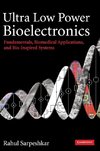
-
 Anglický jazyk
Anglický jazyk
NON-INTRUSIVE LOAD MONITORING (NILM) TECHNIQUES
Autor: Soumyajit Ghosh
The sources from which electrical energy is derived are getting exhausted day by day. So, the need has arisen to look for other renewable sources of energy which would meet the increasing demand. This is where the need of employing smart meter in residential... Viac o knihe
Na objednávku
31.68 €
bežná cena: 35.20 €
O knihe
The sources from which electrical energy is derived are getting exhausted day by day. So, the need has arisen to look for other renewable sources of energy which would meet the increasing demand. This is where the need of employing smart meter in residential houses arises. Smart meter helps householders to understand the pattern of electricity consumption by their houses' appliances and as a result find alternatives to lessen the energy consumption . In the present day a considerable amount of electricity is consumed by the household sector. An awareness among people regarding the consumption pattern will help to reduce electricity consumption . Efficient load monitoring in the metering side of households can improve the household energy management system considerably. In the residential energy monitoring system, the deployment of smart meters will have enormous contribution to the efficient and effective management system of energy. Real-time information, more reliable, secure, about consumers can be accessed by this. Consumers can have information of their energy consumption pattern and thereby use electricity judiciously through the communication between them and utility. The acquisition of data will be faster and more accurate with the concept of smart greed which was not possible earlier on account of lacking real-time information. For collection of real time data residences should be provided with sensors or devices for gathering such information and smart appliances for management and optimization of consumption of energy. Keeping in mind the fact that a smart grid is vital for implementing load monitoring and identification, this chapter deals with the conception regarding smart grid and its effective implementation in residential sector. The identification of loads and its monitoring are also the concerns of this chapter. In recent times, global utility industries are giving much endeavour to address challenges like generation heterogeneity, demand response, reduction in overall emission of carbon and conservation of energy. While conventional power grid, in vogue is unable to address such critical issues, it is expected from smart grid or intelligent grid to cover up the vital deficiency of the power grid used conventionally The rising energy demand and the scarcity of resources have made it extremely important to conserve energy throughout the world. Globally, out of the total energy consumption, consumption of residential energy accounts for a lion's share and it is predicted to rise in the upcoming days. For instance, in the European Union, 40% of the generated electricity is consumed by the residential sector and it is envisaged that the world-wide demand of energy will increase considerably by 2030. In United States too, approximately 35% of the whole energy produced gets consumed by the residential sector. Moreover, this consumption is estimated to rise by 15% by the year 2030 . Apart from energy price hikes and change in climate, the rise in consumption of energy will also affect a country's economy directly. In view of the above, it is very essential to reduce energy consumption, especially at the residential sector, significantly. To achieve this, residential energy consumption monitoring and relaying of data back to the consumers play a significant role.
- Vydavateľstvo: Self Publisher
- Rok vydania: 2023
- Formát: Paperback
- Rozmer: 229 x 152 mm
- Jazyk: Anglický jazyk
- ISBN: 9798889951490











 Nemecký jazyk
Nemecký jazyk